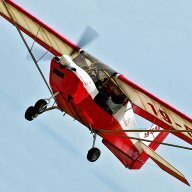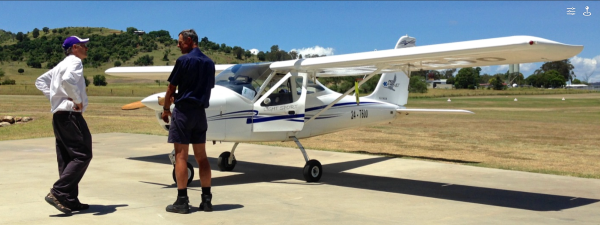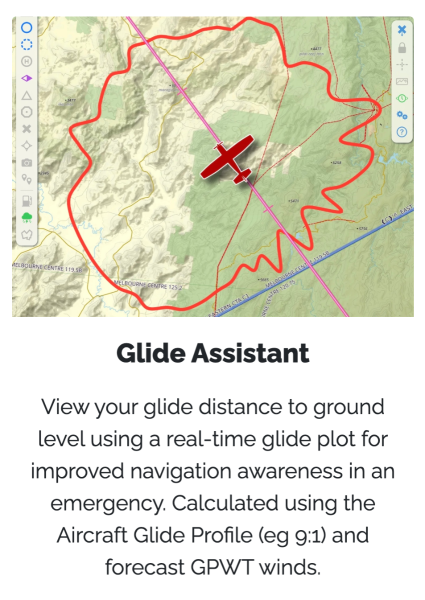-
Posts
3,047 -
Joined
-
Last visited
-
Days Won
67
Content Type
Profiles
Forums
Gallery
Downloads
Blogs
Events
Store
Aircraft
Resources
Tutorials
Articles
Classifieds
Movies
Books
Community Map
Quizzes
Videos Directory
Everything posted by Garfly
-

CASA explains the rules (Please explain).
Garfly replied to Garfly's topic in AUS/NZ General Discussion
Okay, here's a link to that: Draft guidance on radiotelephony procedures - Civil Aviation Safety Authority - Citizen Space CONSULTATION.CASA.GOV.AU Find and participate in consultations run by the Civil Aviation Safety Authority Draft Multi-Part AC 64.B-01, AC 91-35, AC 139-14 and AC 172-04 v1 -

CASA explains the rules (Please explain).
Garfly replied to Garfly's topic in AUS/NZ General Discussion
Simples? But there's no suggestion of any either/or scenarios in the video. The commentary names both as "certain criteria" that must be met. (Not either one criterion or another). "You must not continue approach to land beyond the threshold of the runway until you meet certain criteria. These are: • An aircraft that is taking off from the same runway must have become airborne and commenced a turn. • An aircraft that is taking off from the same runway must be beyond the point at which your aircraft could be expected to complete its landing roll." But, in any case, even if we put it down to clumsy language/video production, how is this of any guidance in the real world? Taking your first scenario - an aircraft that's already taken off, climbed to 500' and turned crosswind then clearly it's no factor. It's everyday circuit work. As to your climbing straight ahead case, at most uncontrolled strips you'd be clearing the far end before turning anyway so that scenario only counts if, turning final, you felt compelled to apply the video's first criterion strictly. (No turn, no land!) But then, looking at the wording of the second of the two criteria, it seems it doesn't even require the aircraft ahead to be airborne in its take-off run - just so long as you reckon you can pull up in time if, say, he suddenly aborts. To me it doesn't look simple at all. It looks like a super stringent rule running concurrently with a really quite liberal one - applied to the same scenario. Take your pick? -
I've been checking out the recent CASA video series "Explaining the rules". Some are sort of useful but this one "Landing Rules at non-controlled aerodromes" has me confused. https://www.youtube.com/watch?v=2EkQagUcwNY&list=PLjm7k4QRw7_spKGYzGOkxBwrWiaDr-srd&index=5 In it, these two slides are shown, one after another. Am I missing something? How is it that these two "explanations" both apply? It's not like there's an "and/or" involved (but even if there was ...??). Anyway, if version 1 wins out, what happens when the aircraft ahead departs upwind?
-

Instructors in the Scenic Rim, Qld area?
Garfly replied to danny_galaga's topic in Student Pilot & Further Learning
Yes, the P92 series like the Echo Super and the Eaglet are known to fly very nicely. Of course, your P96 is one of the low wing Tecnams but I think you'd find the handling qualities of the high wing cousins just as easy and pleasing. This is Mahl (on the left) at Boonah with one of his Eaglets a few years back. -

Instructors in the Scenic Rim, Qld area?
Garfly replied to danny_galaga's topic in Student Pilot & Further Learning
I reckon Mahl Oakes at Fly Now! Redcliffe is a very simpatico instructor who's familiar with your neck of the woods. Plus he operates P92s if you want to stick to type. -
Some interesting observations by Scott Perdue in this vid. (He spends the first five minutes on what viewers got wrong in his previous video. This one starts in earnest after that. Perdue's video prompted this Comment (among others) from one CFI: @christophvz 2 years ago (edited) Thank you for another thoughtful and informative video Scott! These are excellent points and I fully agree with what you said. Your previous video inspired me to practice emergency landings in the real airplane (C182) and spend several hours in my BATD (Redbird TD2). One thing I’ve realized is that I’ve always taught my students just the abridged version - i.e. follow the ABC - Airspeed, Best Place to Land, Checklist. But now I’m realizing that there are more practical considerations that ought to be thought through carefully and practiced extensively. Below are some key points that I’m writing down in my CFI notes. Curious about feedback from other fellow pilots and instructors here. Emergency landing - key points 1. Pitch for Vdmms (defined minimum maneuvering speed, 1.404 x Vs, 72 kts in Cessna T182T), trim to reduce control pressure, and fly at that speed all the way to the ground; do not go above it and do not go below it until flare. Going above it will increase your kinetic energy which will be difficult to manage. Going below it will bring you closer to a stall and loss of control. Just fly Vdmms all the way to the ground. 2. Aim for the best available landing spot, ideally an open field, a runway, a road, a beach, dense trees, or water, in that order. Prioritize not hurting anyone on the ground before saving yourself. Runway is your second best option (unless you are in a tight traffic pattern already or in a high overhead position) because it will make it difficult to consider other options. I call it runway(titis). Aim for either straight in or low key position, or downwind high key position to your intended landing spot. 3. Continuously reevaluate if you can make your intended landing spot and choose the second best option if you know it’s not going to work out; judge if you can make it using your sight picture (i.e. angular distance); do not attempt to stretch the glide. If it’s not working out, accept your situation and remind yourself that your biggest risk is losing control of the airplane. So don’t. 4. Do not make turns below 500 feet; the loss in lift will induce an urge to pull back which will be extremely difficult to resist. Better to crash wings level into a suboptimal space than lose control close to the ground. You only need 30 ft of distance to stop and survive the 9G crash (see FAA flying handbook Chapter 17: Emergency Procedures). 5. Do not put full flaps until landing is 100% assured and you’re ready to flare. Unlatch the doors before touch down. Aim to be slightly high realizing that winds can shift close to the ground. Give yourself good safety buffer (i.e. avoid aiming for the edge of the field for example). 6. Evacuate promptly; do not just sit in the airplane thinking that the worst is behind you. It ain’t over till it’s over.
-

Country Airstrip Guide. What you think?
Garfly replied to NT5224's topic in AUS/NZ General Discussion
-
Whilst on the tricky topic of best-glide, I've found some of this discussion useful: Also, this vid is good at demonstrating that minimum sink is not the same as maximum range (wind effects aside): https://www.youtube.com/watch?v=ZP8KL4j9yA8 Also, I've been playing around with OzRwy's Glide Assistant in a simulator. It can can be used in planning and/or in real time. Not sure if, faced with an engine out situation you'd think to consult it but a quick glance might suggest a direction for longest range - in prevailing winds aloft. Anyway, it automatically cuts out at 1500' AGL probably in order to suggest that now is definitely look-outside time. User guidance here (18.5) : 18. Special Features DOCS.OZRUNWAYS.COM And this academic take is exhaustive (and exhausting) and might interest those who know the maths. Straight Gliding Flight | Academic Flight ACADEMICFLIGHT.COM This article deals with straight gliding flight, as it is encountered during an engine-out emergency or in a glider. Controlling (and maximizing) glide
-
Speaking of wooden propellers - a tall tale, and true, of the Canadian north.
-
It's sad to see young Ido Segev again, as large as life, in this wonderful Mike Rudd video. (He was one of the four pilots lost in the Mangalore mid-air tragedy.) https://www.theage.com.au/national/victoria/fly-ido-young-pilot-remembered-after-two-planes-crash-killing-four-20200220-p542ld.html
-

ABC article alleging "hobby aircraft" not safe
Garfly replied to ClintonB's topic in Aircraft Incidents and Accidents
But back then, we'd never have known each other, right? (And for all that, I reckon it's more for better than for worse ;- ) -

Aero Ex - Valkyrie 1 Design
Garfly replied to Peasant_Pilot's topic in Aircraft Building and Design Discussion
BTW P-P, Chris Weber, the builder of Valkyrie 1684, has said that he feels no special proprietary rights over the name for that one-off of his, so there'd be no need to change it on his account, at least. If you want to confirm that with him, let me know. -

ABC article alleging "hobby aircraft" not safe
Garfly replied to ClintonB's topic in Aircraft Incidents and Accidents
(Then there's the Philomena Cunk school of aviation journalism ;- ) -

Nambucca Heads light aircraft crash 04/01/2025
Garfly replied to trailer's topic in Aircraft Incidents and Accidents
Ch7 News: https://www.youtube.com/watch?v=CI2G7Yo8GZM -
Absolutely, they seem to worry him a lot ... even airframe parachutes worry him - a substitute for good piloting. That must please his GA Cirrus colleagues a lot. I guess their training is never going to save their lives. Equally opinionated folks worry about other things, like the dangers of a GA fleet full of 40 or 50 year old machines. And just look at that shiny RAAus, Bristell leading the story ... but a few years young. What a messed up piece of crap-journalism. Training saved pilot's life Pilot Keith Link from Cohuna in regional Victoria survived a plane crash after the engine of his commercially built Cessna failed mid-flight near Bendigo in 2020. He said his pilot training helped save his life but that more improvements in the sector were needed. Pilot Keith Link survived a light plane crash in 2020. (ABC News: Tyrone Dalton) Mr Link said he wanted licensed aircraft maintenance engineers to sign off on all aircraft after every 100 hours of flight or every 12 months. "When I see a plane with a parachute attached to it, I sort of think that's a substitute for being a good pilot," he said.
-
True, but whenever I've done (dual) engine-off practice glides the Rotax has burst back to life instantly. But still, nobody depends on it so that training is always done within easy reach of an ample runway.
-
Sorry no substance.
-
The scene depicted in the Italian video (above) would be legal here. In pursuit of greater competence and safety, I would gladly seek out such training just as I would seek out, say, upset recovery training.
-
I have also done that kind of testing with a CFI (and we reached the same conclusion) and it is legal under RAAus rules.
-
Unintended touchdown WWW.FLIGHTSAFETYAUSTRALIA.COM As it was a nice day, I thought it would be good to take the plane out for a trip around the local area and was wondering about performing an engine-off landing as I had practised doing them now and again quite...
-
Aren't those the figures you reported in the original post of this thread (4 years ago)? "For the Savannah, 50kts is the speed for best glide ratio, as determined by earlier testing. Times recorded for these tests are - at idle 101 seconds, at prop stopped 94 seconds. At idle - 101sec/1000ft = 594fpm descent rate = 8.5:1 glide ratio @ 50kts. Prop stopped - 94sec/1000ft = 634fpm descent rate = 7.9:1 glide ratio @ 50kts. So for each 1000 feet of descent, the aircraft will glide 8,500ft at idle or 7,900ft with prop stopped. So that’s 600ft (182m) less distance at prop stopped than at idle."
-
While looking for that anti-heat-soak cowl-flap story for re-posting in Skippy's Linear Actuator thread I was taken back to the main topic of JG3's original thread: Prop Stopped. I reckon it's probably worth a bump; some interesting discussion around whether we should, from time to time, practise real dead-stick landings. And then, out of the blue, I came upon this example. (I see the instructor returned the switches to ON ready for a restart if needed) :
-
This'd be the post you're referring to, Marty. As you say (and AFAIK) the device is only meant to reduce heat soak under the cowl on the ground.
-

Strobe, landing and wig wags questions
Garfly replied to Lyndon's topic in Aircraft General Discussion
Agreed, and in the second video story I thought he did well to descend underneath the converging Cessna because even though he too was in a high wing he probably had a better chance of keeping sight of the threat looking forward and upwards until it passed over (as opposed to climbing and losing it under the nose.) In the first story he says they were both vertically constrained by a cloud layer just above circuit overfly height. In that case, he reckoned his take-away was he should have been less fixated on his original joining plan when faced with unexpected same level traffic. -

Strobe, landing and wig wags questions
Garfly replied to Lyndon's topic in Aircraft General Discussion
This fairly recent video by a young YLED (Lethbridge) pilot tells two stories from which, he says, he took lessons about traffic conflicts near airports. The first shows how the other plane's OzRwys traffic helped with separation when his own radio comms were, he thought, somewhat lacking. And the second (04:00), shows how it was the other plane's landing lights that saved the day when that pilot's radio call had placed him somewhere else entirely. I guess we all agree, see-and-avoid needs all the help it can get. Anyway, kudos to FlightFix for sharing what he's learned in such engaging, well produced videos.













